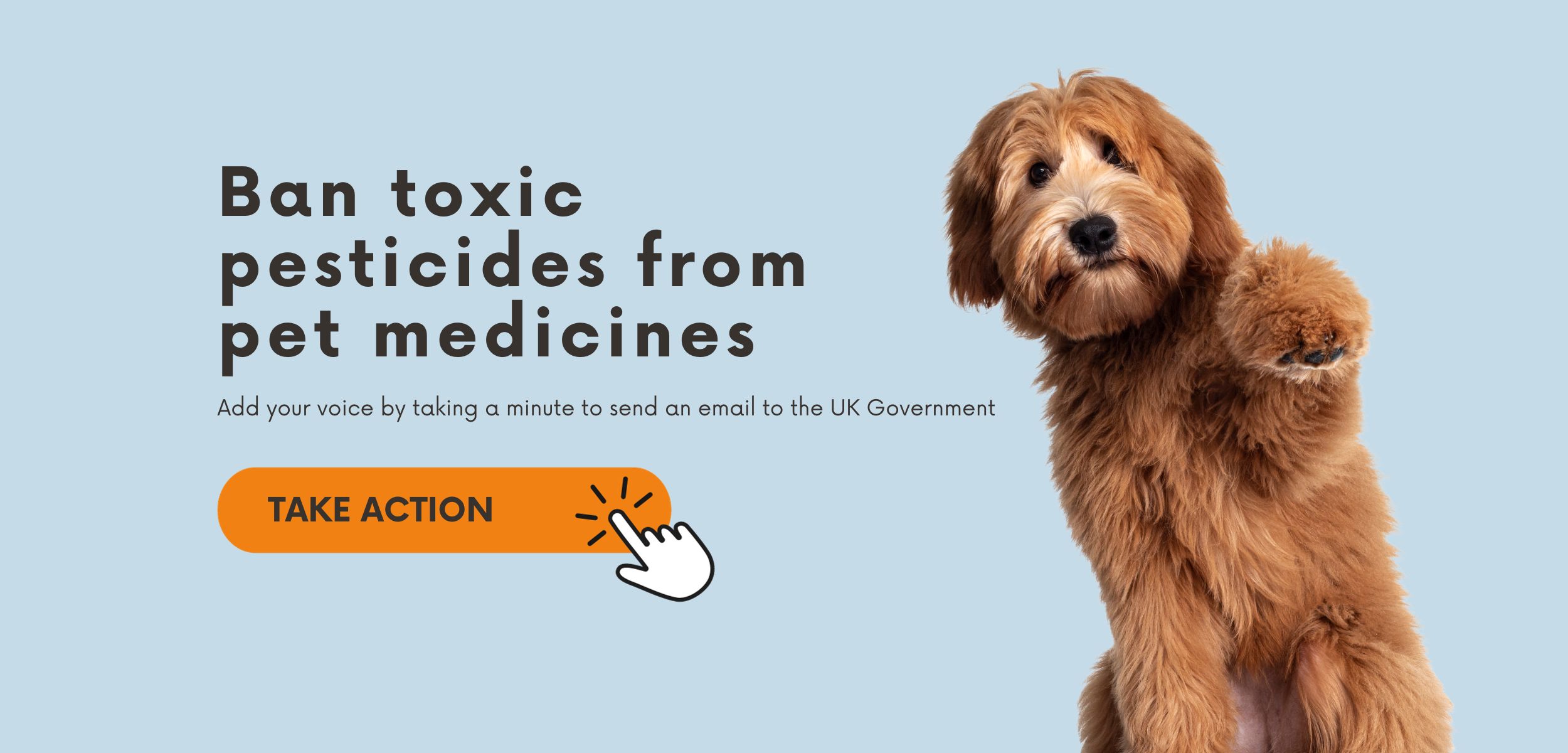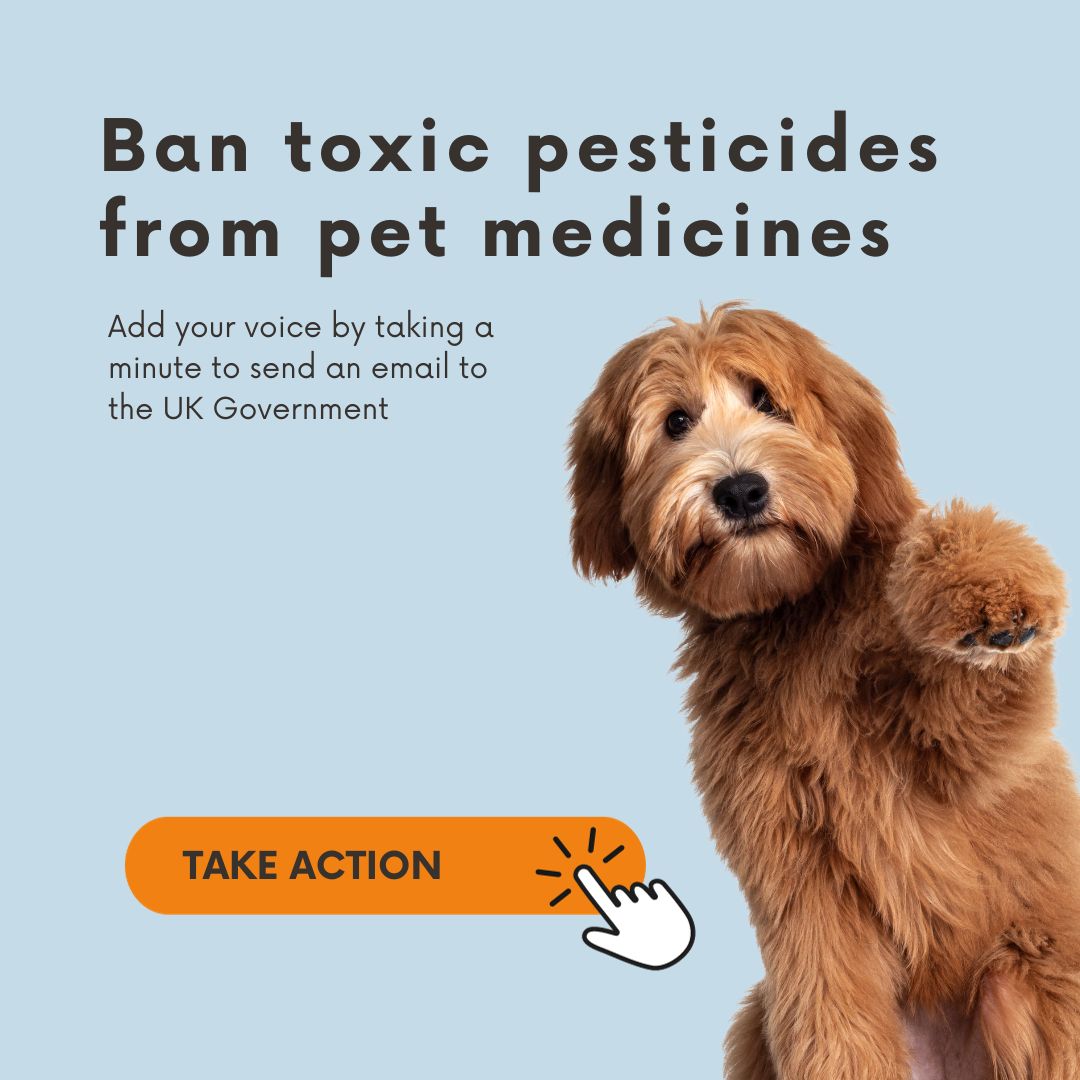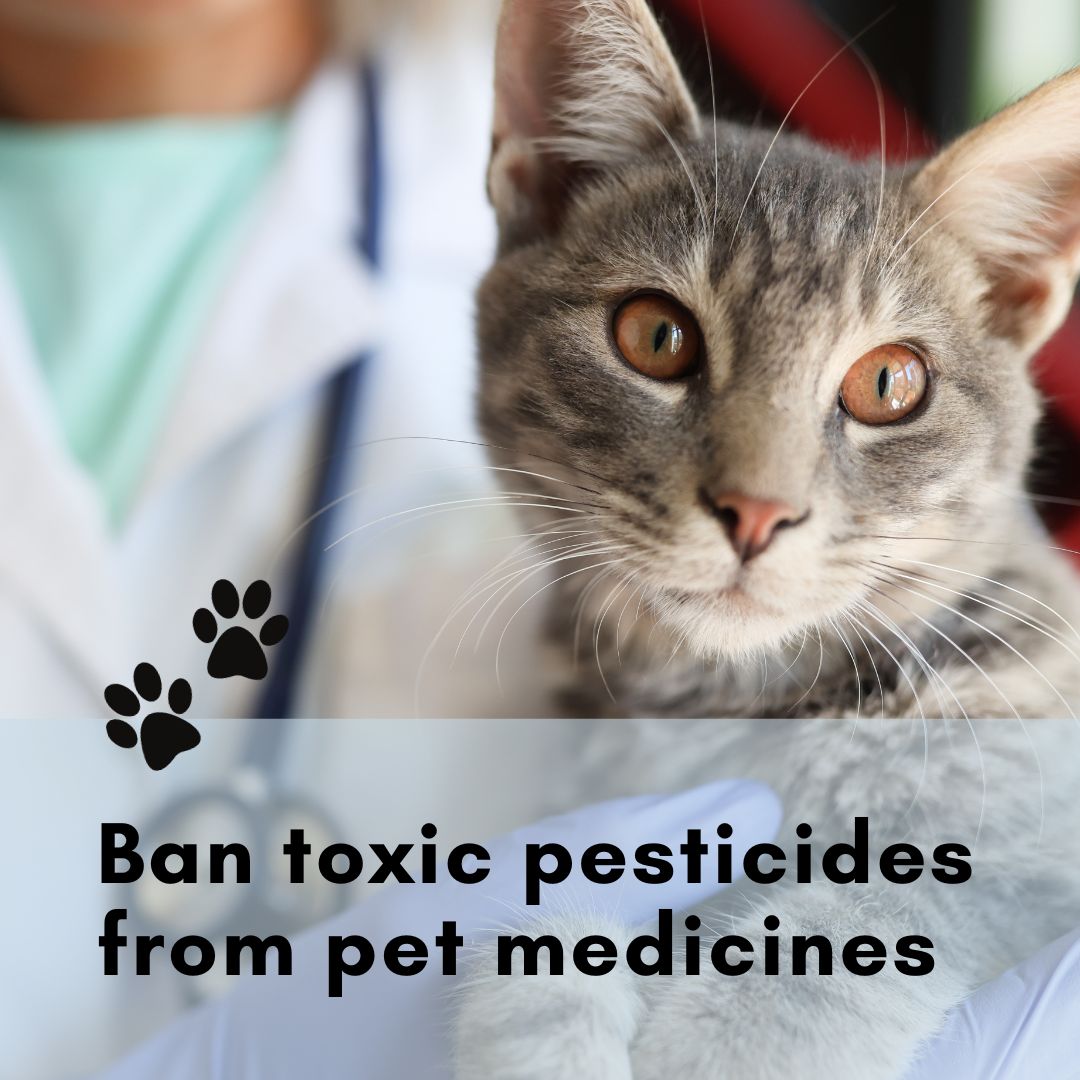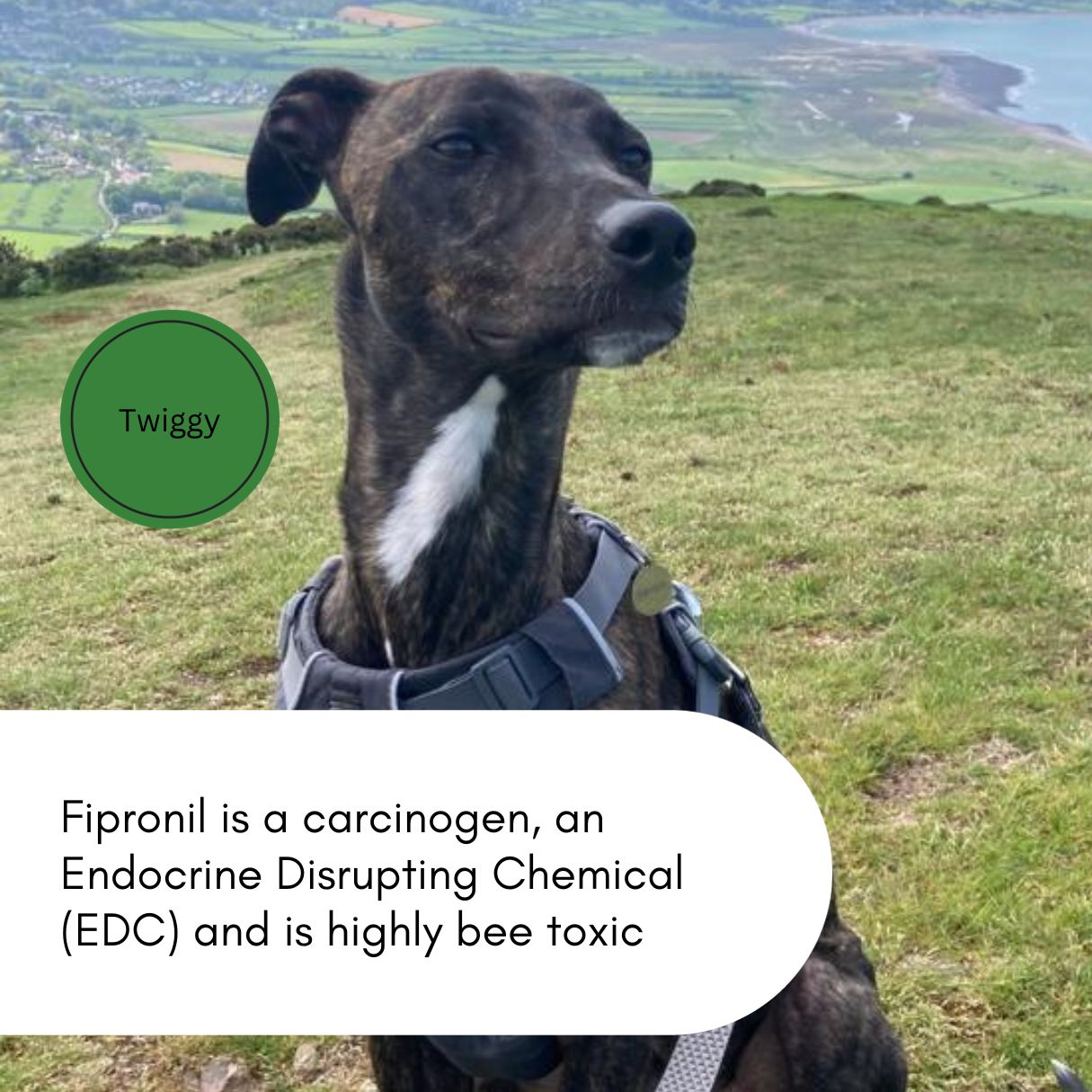
Pesticides in veterinary medicines
The majority of pets are intentionally exposed to pesticides via parasiticides. Parasiticides are veterinary medicines which are used to kill parasites, primarily ticks, fleas, lice and worms. According to the UK government’s Veterinary Medicines Directorate (VMD), there are 1,334 parasiticide products approved for use in the UK. They come in different forms with the most common being spot-on solutions, tablets, or collars. In recent decades it has become the norm for vets to encourage pet owners to use tick and flea treatments regularly on their pets prophylactically, whether they are needed or not.
Potential negative effects of tick and flea treatments on pets
Pesticide active substances included in parasiticides include chemicals that have been linked to a range of serious chronic diseases, including cancer. Despite this, many parasiticide products are available without prescription and can be bought over the counter or online, making accidents more likely to happen. Pet owners with the best of intentions may use the wrong product for their pet, or administer an incorrect dose in terms of the weight or age of their pet which can result in adverse health effects. Even when all the instructions are followed correctly, the reality is that we know almost nothing about the possible chronic (long term) impact on our pets of being treated regularly and over long periods of time with parasiticides.
Potential negative effects of tick and flea treatments on human health
While parasiticides can be important in terms of preventing the transmission of zoonotic diseases from pets to their owners, the chemicals they contain may also be affecting the health of people living in the same household as treated animals. Fipronil and permethrin – pesticide active substances commonly found in tick and flea treatments – have both been found to have links to cancer and are also suspected endocrine disruptors, which means they can interfere with hormone systems causing an array of health problems.
With the majority of pets in regular physical contact with their families, and many allowed to spend time on carpets, sofas and beds, it is unlikely that external tick and flea treatments are contained to the target animal. This is especially true when there are young children in the home who tend to touch pets’ bedding, toys or clothes. Children are also more vulnerable to the effects of pesticides for a range of reasons including the fact that the systems their bodies use to deal with toxins are not as advanced which can make them less able to cope with these substances than adults. Incidents of exposure that would be tolerated by adults, can cause irreversible damage to unborn babies, infants and adolescents.
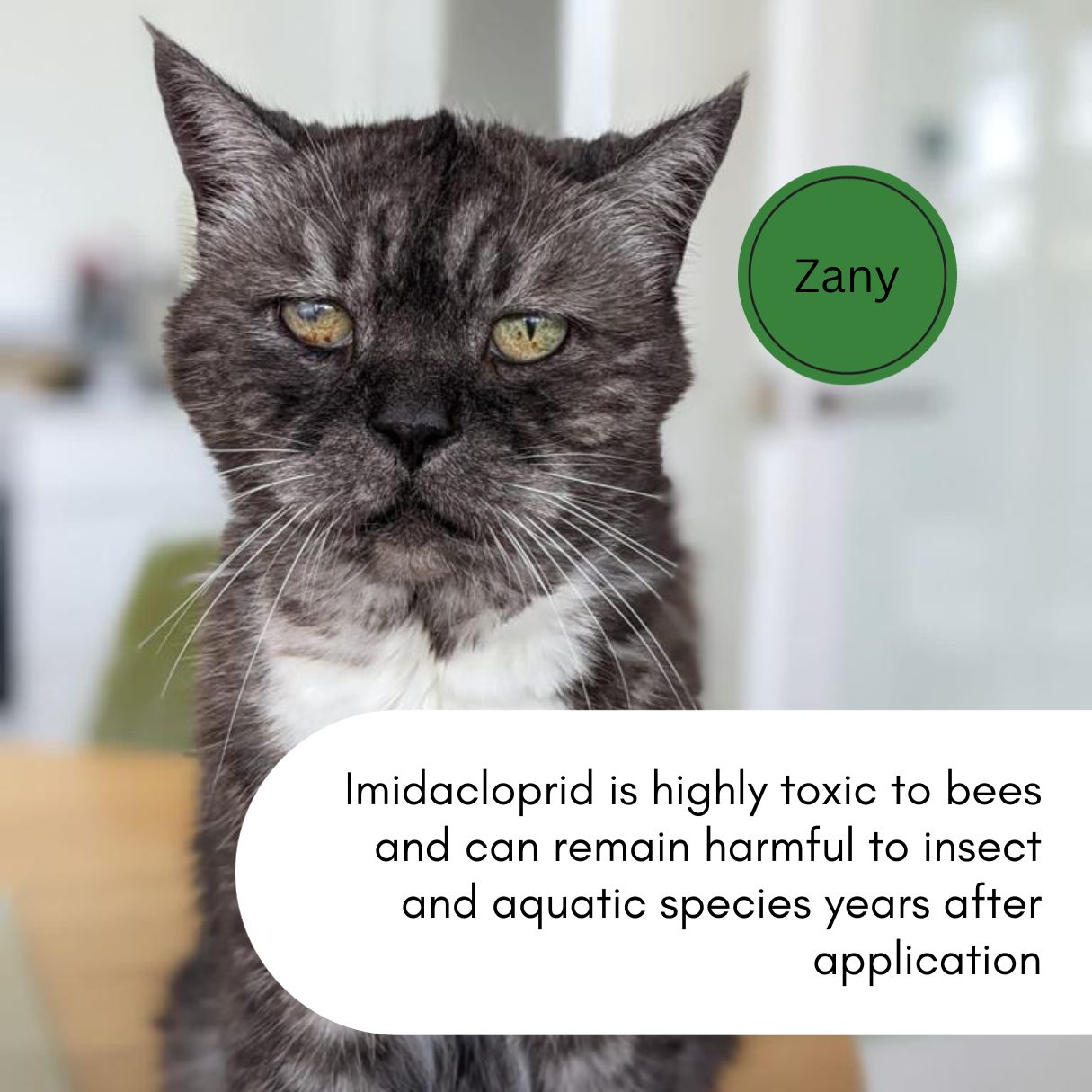
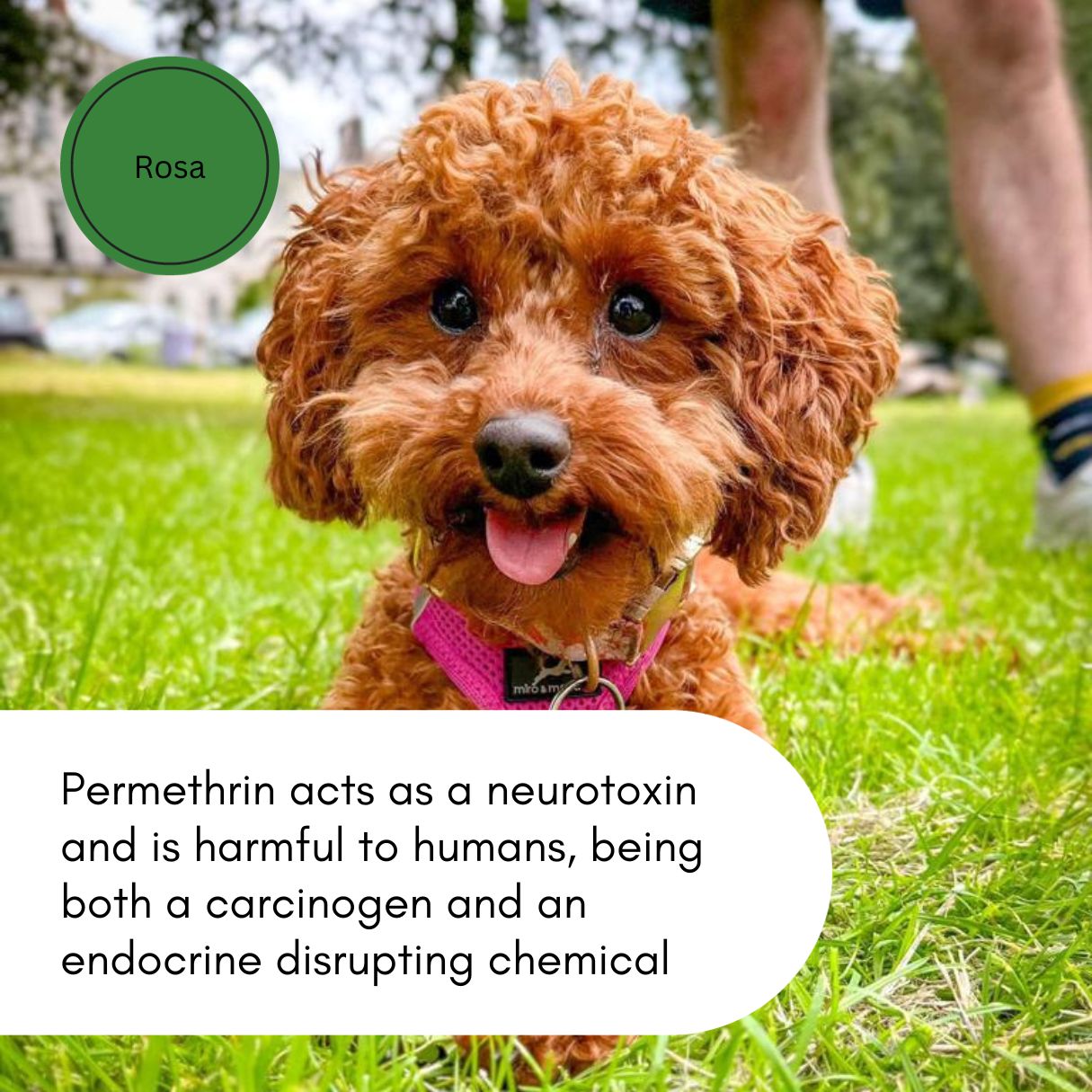
Potential negative effects of tick and flea treatments on the environment
Pesticide active substances contained in parasiticides are also leaching into the natural environment through a range of pathways, including bathing pets and washing their bedding, allowing pets to swim in rivers, and urinary and faecal excretions.
Researchers at Sussex University in 2021 found fipronil in 100% and imidacloprid in 70% of English rivers they tested. While these two active substances have not been permitted for use on UK crops for a number of years due to the harms they cause, they continue to be found in tick and flea treatments. Both active substances are highly toxic to bees, with a single dose on a large dog of the neonicotinoid imidacloprid enough to kill millions of honeybees. The study found that, between 2016 and 2018, concentrations of fipronil far exceeded accepted safe limits, with concentrations of imidacloprid also exceeding safe limits in 7 out of 20 sites. With the highest levels of pollution found immediately downstream of wastewater treatment works, assumptions have been made that these pesticides are largely originating from household drains, a hypothesis that seems to confirm the link back to pets.
A more recent analysis of Environment Agency data which backs up the above findings can be found here. For further information about the risks parasiticides pose to pets, human health and the environment download our report ‘Pets and pesticide poisoning’.
Pesticides not permitted for use on crops but allowed for use on pets
While conducting the research for this report, PAN UK discovered that five pesticides that are not permitted for use on agricultural crops due to their impact on human health and/or the environment are being used widely in tick and flea treatments for dogs and cats. These chemicals are leaching into England’s rivers, posing a risk to aquatic species. Two of the five chemicals are known to contaminate water and all five are highly bee toxic – including three neonicotinoids which are notorious for driving declines in global bee populations. Two of the five are suspected endocrine disrupters and have links to cancer.
This is no small problem. In 2013, the final year during which imidacloprid was approved for use on agricultural crops in the UK, 5,407kg of active substance were applied. In 2017, the amount of imidacloprid used in flea and tick treatments sold by the main UK manufacturer alone totalled 4,000kg of active substance.
New analysis of official Environment Agency river water quality data by the Rivers Trust and Wildlife and Countryside Link reveals that toxic insecticides found in pet medicines are present at 109 of 283 river sites around England. At all 109 sites, at least one of the five chemicals was above proposed EU levels that are considered safe for aquatic life. Efforts to prevent these chemicals from leaching into the environment and affecting wildlife are therefore being undermined by the continued use on pets. Read more here
Recommendations for change
To prevent pesticide active substances found in veterinary medicines for pets from harming the health of animals, humans and wildlife and contaminating the environment, PAN UK recommends that the UK Government:
- Bans all pesticide active substances that are not permitted for use on agricultural crops from being included in veterinary medicines for pets.
- Closes the current loophole to ensure that any pesticide active substance deemed to be too harmful to be used on crops in the future is automatically banned from appearing in veterinary medicines for pets.
- Adapts the approvals process for veterinary medicines to include consideration of potential human health and environmental harms.
- Funds research into less-toxic, and ideally non-chemical, antiparasitic products for pets.
We also recommend that:
- Vets promote alternative veterinary medicines that do not contain pesticide active substances and, wherever possible, discourage pet owners from prophylactic use of veterinary medicines that contain pesticide active substances.
- Supermarkets and pet shops immediately end the sale of veterinary medicine products for pets that contain pesticide active substances and increase the offer of less-toxic and non-chemical alternatives.
Find our full list of recommendations in the report here.
Frequently asked questions
Pesticides are approved in two distinct stages. Firstly, the active substance – the chemically active part of a manufactured pesticide product – is authorised. For the second stage, pesticide products containing that active substance (usually alongside many other ingredients known as ‘co-formulants’) are authorised. For example, the active substance glyphosate had to be approved before it could be allowed to be sold in the pesticide product ‘Roundup’. With that in mind, this is what the classifications in the table above mean:
- Banned – Many pesticide active substances and products are approved but then subsequently found to be negatively impacting human health or the environment once in use, leading to approval being rescinded. There are numerous examples of this happening, perhaps most famously with DDT.
- Never approved – Not all pesticide active substances are submitted for approval in every country. This can be for any number of reasons including; unsuitability for the specific conditions in that country such as landscape, crops or weather, marketing issues or because the pesticide will not meet the regulatory requirements for the administrative region, including the accepted level of threshold for harm.
- No products ever approved – Even when a pesticide active substance is approved for use, a country may choose not to approve any products that contain it due to concerns about its suitability for that particular area or the harms it causes.
- ‘Highly toxic to bees’ – This classification is assigned if the LD50 (lethal dose 50%) for acute and dermal absorption by honey bees is lower than 2 micrograms per bee (μg/bee). The value of LD50 for a substance is the dose required to kill half the members of a tested population after a specified test duration. A lower LD50 is indicative of increased toxicity as it shows that it takes less of a substance to kill half the population.
- ‘Groundwater contaminant’ – Strict limits are set for pesticides in groundwater due to the potential for them to negatively impact drinking water quality and aquatic ecosystems. In order to maintain the integrity of groundwater sources, a precautionary limit of 1µg/L is set for pesticides. Some pesticides regularly exceed this limit and are therefore classified as groundwater contaminants.
- ‘Endocrine disruptor’ – Interferes with hormone systems and can cause birth defects, developmental disorders and reproductive problems such as infertility.
- ‘Carcinogen’ – Capable of causing different types of cancer, including leukaemia and non-Hodgkin’s lymphoma.
It is important to note that if a substance is classified as a ‘carcinogen’ (for example) it does not mean that exposure to it will definitely result in the development of cancer. The classification simply means that in tests for toxicity the substance can cause a particular effect.
Companies that manufacture pesticides are required by national regulators (such as the European Food Safety Authority, US Environmental Protection Agency and UK Health and Safety Executive) to conduct toxicity testing as a key part of the process through which an active substance is approved. The data generated by this toxicity testing is fed into risk assessments which are then used to determine the extent and nature of the potential harm an active substance poses to human health and the environment. When we say an active substance is a ‘water contaminant’ or ‘carcinogen’, it is based on the results of these national risk assessments.
There are a number of databases that collate this toxicity data and regulatory decisions from around the world. To ascertain the impacts of the five active substances listed above, PAN UK used the following two sources:
While voluntary and stewardship approaches may work in other areas, they have repeatedly proven to be ineffective at reducing pesticide-related harms to either human health or the environment for a number of key reasons, including:
Hazard vs. risk-based approaches – Arguably the most fundamental problem with voluntary and/or stewardship approaches to reducing pesticide harms is that nothing is as effective as removing the hazard itself. The UK (along with the EU) currently follows what is commonly called the ‘hazard-based’ approach to pesticide regulation. This means that if an active substance is judged to be intrinsically dangerous – for instance by being able to cause cancer or persistent pollution – then it is too hazardous to be used safely and should be banned. Controlling exposure to hazards is a basic approach to protecting workers and the environment which is applied far beyond pesticides. The fundamental principle underpinning risk management in hazardous industries such as construction and nuclear power is that the first step is to “eliminate the hazard”. Only if this is impossible, should other means of controlling the risk be considered.
The ‘risk-based’ approach sits in direct contrast. It emphasises assessing and managing risks and involves the deployment of specific measures to keep risks below acceptable levels.
To apply these two approaches to veterinary medicines, a hazard-based approach might see the most environmentally harmful active substances banned from appearing in medicines, while a risk-based approach would recommend that owners do not let their pets swim in rivers for a certain length of time after applying a spot treatment. It should be noted that, if the UK implemented the hazard-based approach to its full extent, then active substances deemed to be too harmful to be used on crops would also be banned in veterinary medicines.
Use reduction vs. risk reduction – Another key reason that voluntary approaches don’t work is that they almost always focus on reducing the risks associated to pesticides, rather than reducing the amount of pesticides being used. While ‘use’ is easy to quantify and measure, ‘risk’ is not. By focussing on risk, voluntary approaches manage to block any meaningful action which would reduce the amount of pesticides applied. It sounds obvious, but evidence from around the world shows time and time again that the best way to meet the ultimate goal of reducing harms is to reduce the amount we are using. Or in the case of Highly Hazardous Pesticides, introduce bans to eliminate the hazard all together.
There are many examples of voluntary schemes on pesticides failing. Meanwhile, the body of evidence on the environmental harms caused by pesticide active substances found in medicines for cats and dogs has been growing for more than five years now. Despite many statements of concern from both veterinary and environmental groups over the years, concrete improvements or reductions in use have not occurred. PAN UK and its allies, therefore, believe that it is time to adopt a precautionary, hazard-based approach and ban the pesticide active substances from being included in pet medicines.
An ectoparaciticide is an antiparasitic drug (usually a ‘spot-on’ treatment) used to kill parasites that live on the body’s surface (such as ticks and fleas). In the UK, there are 676 ectoparaciticide products approved for use in veterinary medicines for dogs and cats. Of this total, 523 products (77%) contain one or more of the five active substances listed above.
An endectocide is an antiparasitic drug (usually in tablet form) used to kill parasites that live both inside the body (such as worms) and on the body’s surface (such as fleas). In the UK, there are 218 endectocide products approved for use in veterinary medicines for dogs and cats. Of this total, 58 products (26.6%) contain the neonicotinoid imidacloprid and/or fipronil, which are two of the active substances listed in the table above. None of the other three active substance listed above are included in any endectocides approved for use as a medicine on dogs and cats in the UK.
PAN UK’s 30+ years of expertise is on pesticides used on agricultural crops (or ‘plant protection products’ as they are also known). Therefore, we came to the issue of veterinary medicines with this background and so began our research by looking at active substances that are not approved for use on agricultural crops due to the harms they cause, but are permitted for inclusion in veterinary medicines. We were trying to understand how chemicals such as fipronil and imidacloprid could still be present in UK rivers, despite no longer being used on crops.
This approach led us to a list of nine active substances that are not permitted for use on agricultural crops but are used in veterinary medicines. Of the nine:
- One is approved for use on cattle and sheep (alpha-cypermethrin)
- One is approved for use on honey bees (amitraz)
- One is approved for use on rabbits (cyromazine)
- One is approved for use on salmon (teflubenzuron)
- Five are approved for use on cats and dogs (dinotefuran, fipronil, imidacloprid, nitenpyram and permethrin)
Due to the prevalence of active substances included in medicines for cats and dogs, we decided to focus solely on those species. We had thought that we might include rabbits under a broader heading of ‘pets’ but discovered that, while banning the five active substances in question would leave plenty of alternative products for dogs and cats, this would not be the case if cyromazine was banned for rabbits and so we removed them from the project.
In addition, given that anything to do with livestock links directly to issues around farmers’ livelihoods (and the fact that many British farmers are struggling to make ends meet right now) an initial focus on cats and dogs also feels like an appropriate place to start, since the risks undertaken by those in the agricultural sector arguably outweigh those taken by pet owners.
They are by far the most common animals kept as pets in the UK, with 10.2 million dogs and 11.1 million cats. According to the PDSA, 80% of UK dogs and 82% of cats are treated with parasiticides (more commonly known as tick and flea treatments). Dogs and cats therefore represent a large percentage of the total amount of these products used on UK pets.
Banning the five active substances in question from appearing in medicines for dogs and cats could potentially have a significant impact in terms of preventing environmental harms. As mentioned above, there would still be plenty of alternative medicines available.
Many of the other chemicals used in tick in flea treatments are known to be harmful to human health or the environment. They are, after all, designed to kill living organisms and therefore need to cause harm – at least to the target species – in order to be effective.
By focusing on banning pesticide active substances from inclusion in pet medicines, we are not saying that alternative treatments are safe or even necessarily less harmful. There is so little research out there that, in reality, we simply do not understand the true impacts that the chemicals contained in pet medicines are having on health or environment. We certainly need more research to be conducted in this area, but this should not be a reason for inaction. In fact, this scientific uncertainty is exactly why UK pesticide regulation is underpinned by the precautionary principle which allows regulators to adopt precautionary measures when scientific evidence about an environmental or human health hazard is uncertain and the stakes are high. Under the precautionary principle, regulators do not have to wait for the evidence of harms to be definitive, an often-unattainable goal.
This is why we have focused on banning pesticide active substances known to cause harm. These five chemicals have been through the regulatory system and deemed too harmful for use on crops. It simply makes no sense to allow them to be routinely applied by millions of pet owners every month. If we want to tackle chemical pollution, then we urgently need to take a more holistic approach and close this loophole. Where alternatives exist, which they absolutely do in the case of pet medicines, chemicals known to be harming wildlife should be taken off the market. Meanwhile, the government and others should fund research into less-toxic, and ideally non-chemical, alternatives so that pet owners can rest assured that they are not driving pesticide-related harms to health or environment.
There are currently more than 1,000 parasiticide products for cats and dogs in the UK. While a ban on pesticide active substance being included in pet medicines would mean removing 67% of these from the market, it would still leave almost 350 alternative products available.
The list of alternative products includes spot-on treatments, sprays, gels, treated collars and tablets so owners would continue to have a wide range of choice in terms of how they apply parasiticides to their pet. While the majority of alternative products are prescription only, there would still be products available for owners wanting to buy medicines over the counter or online.
The cost of parasiticide products vary greatly. However, those containing pesticide active substances tend to be roughly comparable with the alternatives in terms of price so a ban should not affect pet owners struggling with the cost of living. It can be argued, in fact, that many pet owners are spending money unnecessarily by treating their pet for parasites every month regardless of whether an infestation has taken place. Pet owners struggling with costs could consider stopping prophylactic use and instead monitoring their pet closely for parasites and only treating if necessary.
What does the future hold?
The pesticide industry has shaped the use of parasiticides over time by focussing upon the most severe health impacts that can be experienced by both pets and humans as a result of parasites. This has encouraged unnecessary, prophylactic use over the past few decades during which time the number of products available has grown enormously. Business is booming. But as public concern regarding the impacts of parasiticides increases, it is vital that the UK government takes control of the situation.
Further reading
Find out more about pets and their exposure to pesticides in our new report here.
Find out more about the organisations supporting a ban on pesticides used in veterinary medicines but not permitted for use on UK crops here.
Please let PAN UK know if you think your pet has been poisoned by pesticides so that we can monitor the national picture and continue to build the case for change. Our pet poisoning reporting form is available here.

